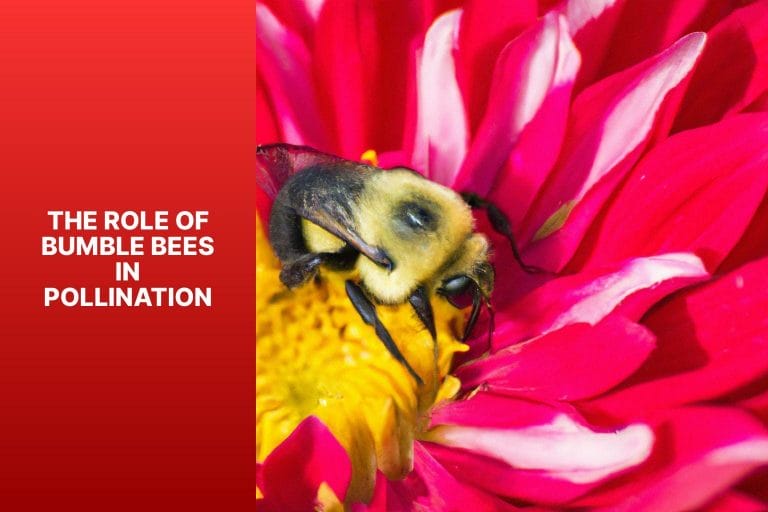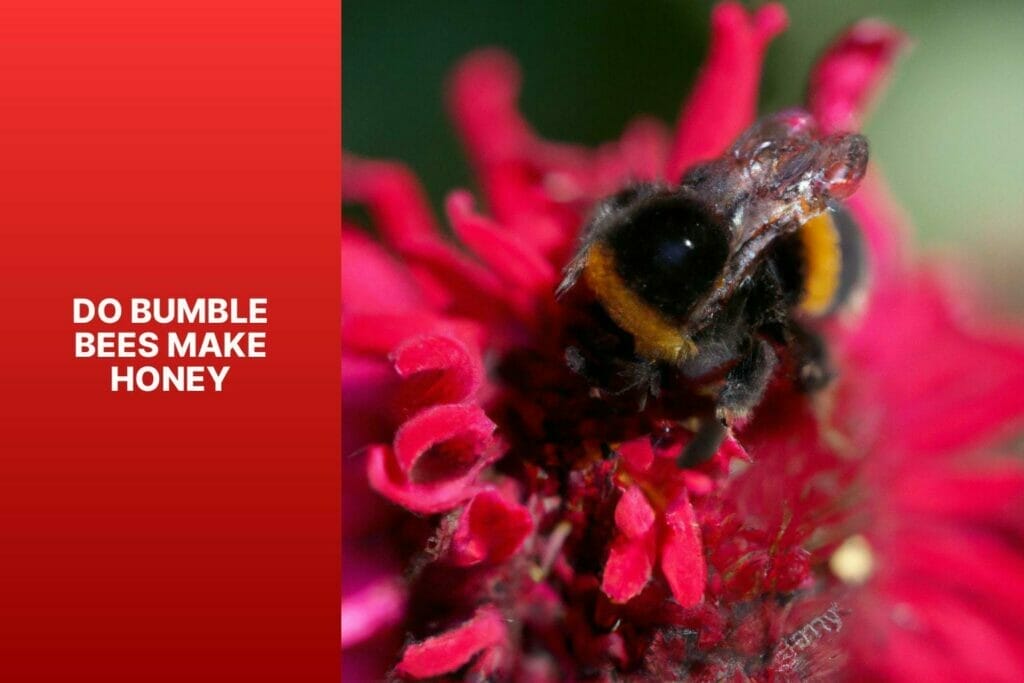Bumble bees are fascinating creatures known for their buzzing flight and important role in pollination. When it comes to honey production, however, bumble bees have some key differences from their honey bee counterparts.
This article will explore the relationship between bumble bees and honey production, shedding light on their unique characteristics and contributions to the ecosystem.
Learning how bees make honey is crucial to understand the connection between bumble bees and honey. The process begins with worker bees collecting Nectar from flowers and carrying it back to the hive.
Through a series of enzymatic processes and evaporative drying, the Nectar is transformed into honey, which serves as a vital food source for the colony, especially during winter.
So, do bumble bees make honey? Unlike honey bees, bumble bees do not have a large-scale honey production system. This is due to various reasons, including their colony size, behavior, and biology.
Bumble bees have smaller colonies and do not accumulate large amounts of honey as honey bees.
One key difference between bumble and honey bees is their foraging behavior. Honey bees are known for their efficient and organized foraging, allowing them to gather and store substantial amounts of Nectar.
Bumble bees, on the other hand, have a more opportunistic foraging style, focusing on immediate food needs rather than long-term storage.
While bumble bees may not produce honey, their significance in the ecosystem should not be underestimated. Bumble bees play a crucial role in pollination, transferring pollen from one flower to another and aiding in the reproduction of various plant species.
Bumble bees collect pollen and Nectar, which they use to feed their young and maintain their energy levels.
Key takeaway:
- Bumble bees do not make honey: Unlike honey bees, bumble bees cannot produce honey.
- Bumble bees play a crucial role in pollination: Bumble bees are important pollinators, helping to fertilize plants and ensure the production of fruits and seeds.
- Bumble bees collect pollen and Nectar: Instead of producing honey, they collect pollen and Nectar as their main food source.
How Do Bees Make Honey?
Have you ever wondered how those busy little bees work together to create the sweet Nectar we know as honey? In this section, we’ll explore the fascinating process of honey production.
From the crucial role played by the tireless worker bees to the intricate teamwork involved, you’ll gain a deeper understanding of the incredible journey these bees embark upon to bring us this golden delight.
Get ready to delve into the buzzing world of honey-making!
The Role of Worker Bees in Honey Production
Worker bees play a crucial role in the production of honey. They diligently collect Nectar from flowers and effectively communicate their discoveries to other worker bees through the fascinating waggle dance.
This unique dance enables them to convey the precise direction and distance of the flowers, facilitating the task of locating them for fellow worker bees.
Upon discovering a flower, a worker bee skillfully employs her long snout to extract the Nectar, which she promptly stores in her specialized honey stomach, distinct from her regular stomach.
This distinct separation enables her to safely transport the Nectar back to the hive without undergoing digestion.
Subsequently, within the hive, the worker bee regurgitates the Nectar into the mouth of a house bee. These house bees then contribute enzymes that break the intricate sugars into simpler ones.
This process repeats until the Nectar is transformed into the finalized honey product.
The worker bees distribute the honey evenly across the honeycomb and diligently employ their wings to eradicate excess moisture. This careful action results in the honey becoming thicker and more concentrated.
When the honey reaches the desired consistency, the bees meticulously seal the cells within the honeycomb using beeswax. This serves the dual purpose of guarding the honey and storing its vital product.
Do Bumble Bees Make Honey?
Unlike honey bees, Bumble bees do not make honey in large quantities. They lack specialized workers called “nectar foragers” to collect Nectar from flowers and process it into honey at the hive.
The lifestyle of bumble bees is different from honey bees, as they do not store honey in their nests.
Instead, bumble bees focus more on raising their young and have a simpler social structure. They create smaller nests and do not accumulate large amounts of honey. Bumble bees collect Nectar primarily to feed themselves and their young.
While bumble bees produce a small amount of honey, it is mainly used for their consumption rather than stored for long periods. Harvesting or collecting bumble bee honey is not done in the same way as honey bees’ honey.
Interestingly, bumble bees are essential pollinators and play a significant role in pollinating various plants, including many crops that contribute to our food supply.
Differences Between Bumble Bees and Honey Bees
1. Size: Bumble bees and honey bees are larger.
2. Nesting Habitat: Bumble bees nest in underground burrows, while honey bees nest in hives or artificial structures.
3. Social Structure: Bumble bees are more solitary, while honey bees live in large colonies with a queen.
4. Colony Size: Bumble bees have smaller colonies, while honey bees have larger colonies.
5. Sting Defense: Bumble bees can sting multiple times, while honey bees can only sting once before dying.
6. Pollination Efficiency: Bumble bees are less efficient in pollination than honey bees.
7. Honey Production: Bumble bees do not produce honey but produce honey for food storage.
Pro-Tip: Understanding the differences between bumble bees and honey bees is important for beekeepers and those interested in pollination. While honey bees are known for their honey production and efficient pollination, bumble bees also play a crucial role in pollinating flowers and crops. Both bees are valuable contributors to the ecosystem and should be protected for their important roles in plant reproduction and food production.
Can Bumble Bees Produce Honey?
No, they cannot. Here’s why:
– Physiological differences: Bumble bees, unlike honey bees, have shorter tongues. This makes it difficult for them to access the Nectar deep within flowers where the sweet liquid is found.
– Lack of storage: Bumble bees also lack specialized honey stomachs for storing and transporting Nectar back to the hive for honey production.
– Colony size: Bumble bee colonies are significantly smaller than honey bee colonies. While a typical bumble bee colony consists of only a few hundred to a few thousand individuals, honey bee colonies can have tens of thousands of individuals. This smaller colony size of bumble bees doesn’t provide the necessary workforce to collect and process large quantities of Nectar for honey production.
Although bumble bees don’t produce honey, they play a vital role in pollination. They are excellent pollinators and contribute to the reproduction of many flowering plants.
Bumble bees collect pollen and Nectar as a food source to sustain their colonies. So while they don’t make honey, they are still incredibly important for the ecosystem.
The Role of Bumble Bees in Pollination

Photo Credits: Savethebeesproject.Com by Brian Adams
Bumble bees play a crucial role in pollination by transferring pollen from male to female flower parts, aiding in plant reproduction. These bees are effective pollinators due to their large size and fuzzy bodies, which enable them to collect and carry a significant amount of pollen.
In addition, they also perform “buzz pollination” by vibrating their wings, releasing pollen from certain flowers. Bumble bees contribute to biodiversity by pollinating various plants in different environments, including crops and wildflowers.
The decline of bumble bee populations can significantly affect plant reproduction and ecosystem health. Habitat loss, pesticide exposure, and climate change threaten bumble bees and their vital role in pollination.
Therefore, it is crucial to conserve and protect bumble bee populations to ensure the continuous pollination of plants and the maintenance of biodiversity.
What Do Bumble Bees Collect Instead of Honey?
Bumble bees have long been associated with honey production, but have you ever wondered what they collect instead of honey? This section explores the intriguing world of bumble bee foraging habits.
From their diligent pollen collection to their thirst for Nectar, we’ll uncover the fascinating ways bumble bees gather the essentials for survival.
Get ready to be amazed by the diverse strategies these buzzing pollinators employ in their quest for sustenance.
Pollen Collection by Bumble Bees
Pollen Collection by Bumble Bees is crucial for the process of pollination. Bumble bees have a unique ability to collect pollen from flowers using their specialized bodies and legs.
They gather and store the pollen in special structures known as pollen baskets or corbiculae on their hind legs. Bumble bees then carry the collected pollen back to their nests and transfer it between different flowers while foraging, which aids in cross-pollination.
Within the bumble bee colony, pollen plays a critical role as a source of protein for both the developing brood and adult bees.
By understanding the significance of bumble bees in pollen collection, we can truly appreciate their contribution to the ecosystem and ensure the continued existence of diverse plant species through effective pollination techniques.
Nectar Collection by Bumble Bees
Regarding nectar collection, bumble bees have unique methods and preferences. Here are some key points to consider:
– Bumble bees collect Nectar from flowers as a source of food. They use their proboscis, a long, tube-like tongue, to extract Nectar deep inside the flower.
– Bumble bees are efficient in nectar collection, collecting large amounts quickly. This efficiency is crucial for their survival and colony growth.
– Bumble bees are attracted to flowers with bright colors, particularly blue, yellow, or purple ones. They prefer flowers with a tubular shape that makes accessing Nectar easier.
– While collecting Nectar, bumble bees unintentionally help pollinate by transferring pollen between flowers, facilitating plant reproduction.
– The nectar collection behavior of bumble bees is essential for the survival and diversity of plant species. Their visits to various flowers contribute to cross-pollination and the overall health of ecosystems.
To attract bumble bees to gardens, it is recommended to plant a diverse range of flowers with bright colors and tubular shapes. Providing a food source for bumble bees benefits these pollinators and enhances the overall biodiversity and beauty of the surrounding environment.
Benefits of Bumble Bees in the Ecosystem
Bumble bees, as pollinators, play a vital role in ecosystems, offering numerous benefits. Here are some of the advantages of bumble bees in the ecosystem:
- Pollination: Bumble bees exhibit excellent pollination skills by vibrating their flight muscles to dislodge pollen, effectively aiding in plant reproduction and growth.
- Biodiversity: Their involvement in pollination allows bumble bees to contribute to the increase in biodiversity and create healthy ecosystems.
- Food Chain: Bumble bees hold a crucial position in the food chain as they facilitate the reproduction of flowering plants, providing a vital food source for other animals within the ecosystem.
- Environmental Indicators: Monitoring bumble bee populations can indicate an ecosystem’s overall health and stability, assisting researchers in understanding environmental changes.
- Economic Importance: The pollination services provided by bumble bees directly contribute to the economy. By enhancing crop yields, bumble bees benefit agriculture and ensure food security.
Recognizing the valuable benefits of bumble bees enables us to protect and conserve them, ensuring a sustainable future for all.
Some Facts About “Do Bumble Bees Make Honey”:
- ✅ Bumble bees do not produce honey as honey bees do. (Source: Scottish Bee Company)
- ✅ Nectar is the raw material that plants produce to attract pollinators, and bumble bees collect it as a vital food source. (Source: Scottish Bee Company)
- ✅ Bumble bees use Nectar for energy and to feed the queen, but it is consumed fairly rapidly and does not go through the transformation process to become honey. (Source: Scottish Bee Company)
- ✅ Honey bees collect Nectar to store it for winter and convert it into honey. (Source: Scottish Bee Company)
- ✅ Bumble bees have their version of nectar stores, sometimes called “honey pots.” (Source: Scottish Bee Company)
